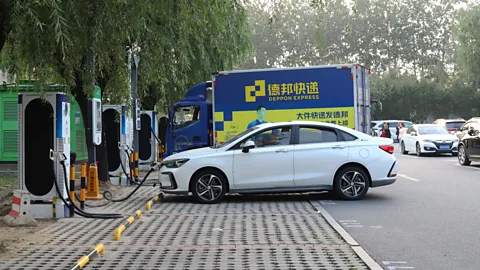China’s State Grid – the largest utility company in the world – began researching battery swaps for electric vehicles around 2006. It was seen as a way around a large-scale transformation of the power grid, as its reliance on pre-charged batteries meant charging could be done at more flexible times and places.
“After comprehensive consideration, China decided to have a route to do battery swaps,” says Liu.
At the time, China had few electric vehicles on its roads; even a decade later it had only 500,000. By 2023, it had 16 million pure electric and six million more hybrid cars, with more than one in every three new car registrations that year electric or hybrid. It also had some 8.6 million charging points, over a third of them added in 2023 alone.
Plug-in battery cars have dominated EV growth in China, but by 2021 it had also built at least 900 battery swap stations. That same year, it officially launched a pilot battery swap scheme in 11 cities. These projects are now scaling quickly: in 2023, China added around 1,600 new battery swap stations, bringing the total to some 3,570 stations, according to Chinese government data.
However, not all EVs are capable of battery swapping – the stations must be compatible with the car’s battery system, so only certain models that are designed for it can make the switch.
At present, battery swaps are most widely used by commercial vehicles such as taxis and logistics vehicles, not passenger cars. Several Chinese experts told the BBC that’s because, in several ways, the battery swap model has proven to be less advantageous than simply charging.
A two-horse race
In China, charging technology is constantly developing. Mainstream electric vehicles in China will support high-voltage fast charging of 800V and above by this year, according to one report. Major Chinese automakers such as BYD, Xpeng and Nio have now developed vehicles equipped with super-charging technology, which takes 15 minutes or so to charge batteries from 10% to about 80%. In March 2025, BYD announced a new charging system which it says can deliver 400km (250 miles) of range in five minutes of charging, making them twice as fast as Tesla’s superchargers. BYD plans to roll out a network of 4,000 of these “flash-charging” stations across China.
 Iris Liu
Iris LiuBy the end of 2026, over 13 million vehicles in China are expected to be equipped with high-voltage fast charging. “Overall, range anxiety is decreasing,” says Liu. The country accounted for almost two-thirds of the 17 million EVs sold globally in 2024, a surge driven by China’s push to reduce dependence on imported oil and establish global leadership in green technologies.
The ownership question is another thing holding back battery swaps for private vehicles, both in China and elsewhere. Battery swaps inherently require car owners to relinquish ownership of a particular battery. If a car owner has just bought a new car and swaps its battery on the motorway, for example, they will very likely receive an older battery. Many car companies are aware of this issue, and some have adopted a business model of separating the car and the battery: consumers buy their cars without batteries, which they rent directly from the company.
Some companies have developed mobile battery swap vehicles, which can charge batteries in locations with lower electricity prices – Lulu Xue
But this business model requires automakers to own and manage a large number of batteries, tying up significant capital and increasing financial risk.
Popularising battery swap stations will also require automakers to accept a unified battery pack standard, so batteries can be interchanged more freely, says Jing Yang, director at the Asia-Pacific corporate ratings division of Fitch Ratings, a credit rating agency based in New York. Carmakers, however, are reluctant to do this, she says: mastering their own battery technologies is an important way for them to maintain industry influence.
And while battery swaps would appear to solve range anxiety, it currently isn’t always the case. A Nio owner I meet at the battery swap station near the Beijing Olympic Sports Centre tells me that while the time to swap the battery itself is indeed very fast, the swap stations need to reliably have a fully charged battery and few people in line to avoid long wait times. Once, he says, when visiting the suburbs, he almost missed an important meeting back in the city because no fully charged batteries were available.